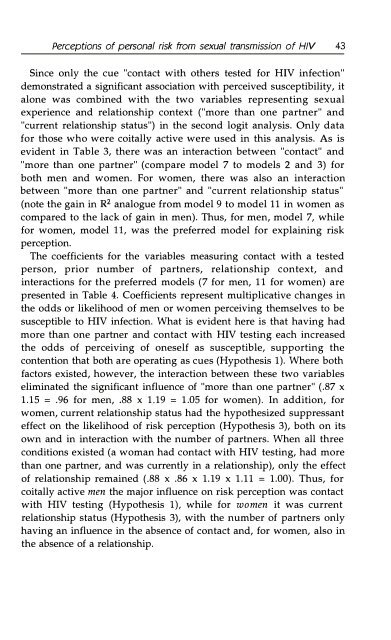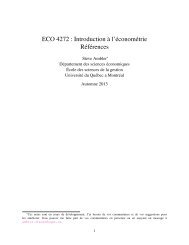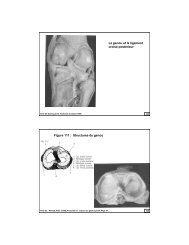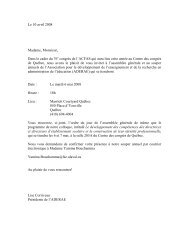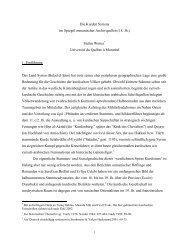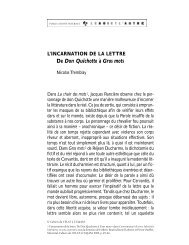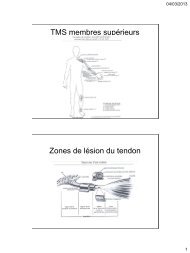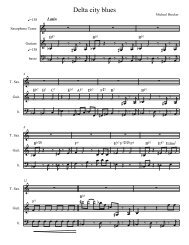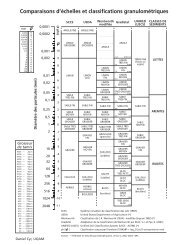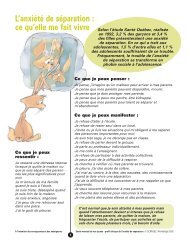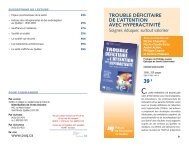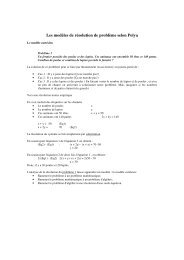Télécharger la revue en format "pdf". - UQAM
Télécharger la revue en format "pdf". - UQAM
Télécharger la revue en format "pdf". - UQAM
Create successful ePaper yourself
Turn your PDF publications into a flip-book with our unique Google optimized e-Paper software.
Perceptions of peronal risk tom sexual transmission of HIV 43<br />
Since only the cue "contact with others tested for HIV infection"<br />
demonstrated a significant association with perceived susceptibility, it<br />
alone was combined with the two variables repres<strong>en</strong>ting sexual<br />
experi<strong>en</strong>ce and re<strong>la</strong>tionship context ("more than one partner" and<br />
"curr<strong>en</strong>t re<strong>la</strong>tionship status") in the second logit analysis. Only data<br />
·<br />
for those who were coitally active were used in this analysis. As is<br />
evid<strong>en</strong>t in Table 3, there was an interaction betwe<strong>en</strong> "contact" and<br />
"more than one partner" (compare model 7 to models 2 and 3) for<br />
both m<strong>en</strong> and wom<strong>en</strong>. For wom<strong>en</strong>, there was also an interaction<br />
betwe<strong>en</strong> "more than one partner" and "curr<strong>en</strong>t re<strong>la</strong>tionship status"<br />
(note the gain in R2 analogue from model 9 to model 11 in wom<strong>en</strong> as<br />
compared to the <strong>la</strong>ck of gain in m<strong>en</strong>). Thus, for m<strong>en</strong>, model 7, while<br />
for wom<strong>en</strong>, model Il, was the preferred model for exp<strong>la</strong>ining risk<br />
perception.<br />
The coeffici<strong>en</strong>ts for the variables measuring contact with a tested<br />
person, prior number of partners, re<strong>la</strong>tionship context, and<br />
interactions for the preferred models (7 for m<strong>en</strong>, 11 for wom<strong>en</strong>) are<br />
pres<strong>en</strong>ted in Table 4. Coeffici<strong>en</strong>ts repres<strong>en</strong>t multiplicative changes in<br />
the odds or likelihood of m<strong>en</strong> or wom<strong>en</strong> perceiving themselves to be<br />
susceptible to HIV infection. What is evid<strong>en</strong>t here is that having had<br />
more than one partner and contact with HIV testing each increased<br />
the odds of perceiving of oneself as susceptible, supporting the<br />
cont<strong>en</strong>tion that both are operating as cues (Hypothesis 1). Where both<br />
factors existed, however, the interaction betwe<strong>en</strong> these two variables<br />
eliminated the significant influ<strong>en</strong>ce of "more than one partner" (.87 x<br />
1.15 = .96 for m<strong>en</strong>, .88 x 1.19 = 1.05 for wom<strong>en</strong>). In addition, for<br />
wom<strong>en</strong>, curr<strong>en</strong>t re<strong>la</strong>tionship status had the hypothesized suppressant<br />
effect on the likelihood of risk perception (Hypothesis 3), both on its<br />
own and in interaction with the number of partners. Wh<strong>en</strong> all three<br />
conditions existed (a woman had contact with HIV testing, had more<br />
than one partner, and was curr<strong>en</strong>tly in a re<strong>la</strong>tionship), only the effect<br />
of re<strong>la</strong>tionship remained (.88 x .86 x 1.19 x 1.11 = 1.00). Thus, for<br />
coitally active m<strong>en</strong> the major influ<strong>en</strong>ce on risk perception was contact<br />
with HIV testing (Hypothesis 1), while for wom<strong>en</strong> it was curr<strong>en</strong>t<br />
re<strong>la</strong>tionship status (Hypothesis 3), with the number of partners only<br />
having an influ<strong>en</strong>ce in the abs<strong>en</strong>ce of contact and, for wom<strong>en</strong>, also in<br />
the abs<strong>en</strong>ce of a re<strong>la</strong>tionship.


